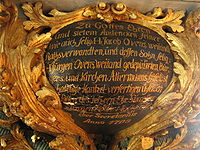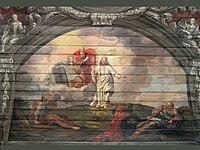St. Laurentius (Tönning)
The St. Laurentius Church in Tönning is a Lutheran, originally medieval hall church on the Eiderstedt peninsula . From the outside, its baroque tower is particularly striking, at 62 meters the second highest church tower in southern Schleswig .
The story of St. Laurentius
The Tönningen town church bears the name of St. Laurentius . As early as 1186, a house of worship was built on the site of today's church, which was constantly rebuilt and expanded in the following centuries. The entire church is built in brick . The north wall with its small, arched windows still bears witness to the originally Romanesque building. The south wall of the church was later modernized with the large Gothic windows after it was probably badly damaged by the Dithmarschers in the 15th century.
In 1527 the Reformation prevailed in Tönning, so that St. Laurentius became Lutheran. In 1593 the first organ was installed. The choir was added around 1633 ; although it can be attributed to the early baroque period , it was built in a Gothic style. During the Great Northern War in 1700, both the church and its tower were badly damaged by fire, and some cannonballs are still stuck inside the masonry today. During the repair work in 1703 the nave was spanned with a wooden barrel and filled with a large ceiling painting until 1704.
After this time there were only minor changes until the middle of the 20th century, but extensive renovations in the 20th century. Above all, they tried to preserve the old, but made significant changes to the building fabric. It was made possible by Gert Cornils Davids, who was born in Tönningen, through his inheritance. In 1956 a new roof, new floor, new chairs and heating came into the church, but a north gallery disappeared instead. In 1959 new windows were added in the chancel, and in 1964 parts of the south wall. In 1961 the tower got its original copper roofing back, in 1966 and 1967 new bricks in the old monastery format replace damaged masonry in the church tower.
tower
The tower rests on a field stone plinth from the time it was built and, like the church itself, was made of brick; the mighty shaft wore various spiers over the course of its history. In a view of Tönning from the years 1572/1573 the tower is shown with a flat gable roof and a belfry resting on it , later modifications gave the helmet a slender pyramid top. Part of it burned down after a lightning strike in 1686, but was then rebuilt in its old form. While the Danish King's army besieged and bombarded Tönning fortress in April / May 1700 during the Great Northern War, the helmet finally fell into the nave, so that an extensive renovation of the church and tower was necessary.
For the design, master builder Jacob Bläser was based on the tower of St. Trinitatis in Altona, then Holstein . The building there had already been imitated in Tönning's neighboring community of Tating , albeit on a smaller scale. The construction work on the new helmet lasted from 1703 to 1706, the funds for this were collected through a lottery, among other things. When it was completed, the tower was the highest in the Duchy of Schleswig with a height of 92 meters . Several cannon balls in the masonry, an iron number anchor on the south side of the tower and the year 1708 on two sides of the dial remind of the siege and the new building. Together with the four towers of Tönninger Castle , it formed an impressive city silhouette until it was destroyed.
In 1795 and 1886 lightning struck the tower and caused some damage, in 1879 a new clock was installed. In 1938 an airplane brushed against the helmet, which was then only poorly repaired, the copper plates were even confiscated for war purposes in 1944 and the hood was covered with zinc plates. It was not until 1961 that the copper roofing of the tower was able to be restored to its previous state, so that this year also appears on the dial. In 1966/1967 the community finally renewed parts of the masonry.
Interior
The interior of the church is rich in furnishings, most of which date from the 16th and 17th centuries .
- Rood screen and triumphal cross group
The rood screen from 1635, a half-height carved oak wall, separates the choir with the altar from the community room. At the top it has been expanded into a gallery that can be entered via a spiral staircase. The rood screen is pierced by 33 brass columns ( docks ), each with the name of a donor. The carved coats of arms and initials of Johann Adolph Kielmann von Kielmannsegg and Marie Elisabeth, née von Osterhausen, are carved over the middle grille .
A late Gothic triumphal cross from around 1500 hangs above the rood screen. It shows a realistically depicted Jesus as a gaunt dying man, next to him are John and Mary. Square evangelist symbols can be found at the end of the cross .
- Altar
In the choir, which is laid out with marble slabs , there is an eight meter high painting altar, the main motif of which is the crucifixion of Jesus. The basic form of the altar dates from 1634, after being damaged in 1700 it was provided with further carvings. Below the main painting is a picture of the Lord's Supper, above a resurrection. The painter of the two pictures above is unknown; they are mannerist paintings that are typical of the transition from Renaissance to Baroque. The style is similar to that of Marten von Acht and his school. In 1962/1963 Barbara Rendtorff restored it.
- Baptismal font
also in the choir is the baptismal font . According to the church chronicle, the stone made of black marble and alabaster was donated by the shoemaker Broder Peters in 1641. The font, presumably created by Hans Ochs , has six reliefs, one of which shows the shoemaker's house brands : high boots and shoemaker's tools. The other five reliefs show classic motifs of many baptismal fonts: the birth, circumcision and baptism of Christ, “let the little children come to me” and the conversation between Jesus and Nicodemus . The corresponding baptismal cover dates from 1704 and shows six putti making music between a tendril-like carving. It is crowned by John the Baptist and a dove symbolizing the Holy Spirit. - Pulpit
The pulpit dates from 1703, probably made by Hinrich Röhlke from Hamburg in the baroque style. The donation from Jacob and Jürgen Ovens as well as Jürgen Möller is characterized by its lavishly carved and gilded ornaments and bears an inscription in a hanging cluster below the floor that refers to their donors. The underside of the pulpit lid shows a Pentecost painting on which a dove as a symbol of the Holy Spirit can be seen particularly well from the ground. The also rich carving is crowned by a Moses figure, which is surrounded below by the four evangelists.
- Ceiling painting, stalls Barthold Conrath from Hamburg
made the mighty ceiling painting in 1704, an extensive restoration took place in 1961. It is one of the most important baroque paintings in Schleswig-Holstein. The parish chairs are from the beginning of the 18th century, but also contain intermediate pieces of an older chair from the 17th century.
Organs
Main organ
The large baroque organ by Joachim Richborn from 1681 was extensively rebuilt in 1902 by Wilhelm Sauer . The Rückpositiv was removed and the Hauptwerk case widened. Another renovation in 1961 was unsatisfactory. In 1978 Hinrich Otto von Paschen renewed the interior while retaining the old prospectus . Since then , the organ has had 41 stops , which are divided into three manuals and pedal . The key action of the organ is electrically, the key action mechanically.
The disposition is as follows:
|
|
|
|
||||||||||||||||||||||||||||||||||||||||||||||||||||||||||||||||||||||||||||||||||||||||||||||||
- Coupling : Hw / Sw, Hw / Bw, Sw / Bw, P / Hw, P / Sw, P / Bw
- Playing aids : 16 composer combinations , tutti, pleno, single tongue storage
Rood organ
In Schleswig-Holstein, the rood screen organ that stands on the rood screen and that complements the main organ is very rare. It goes back to a donation made by councilor Peter Tetens in 1739, as the main organ was in a very bad condition at that time. After a rather inglorious history of neglect, the Tönninger citizens finally collected in order to have the organ completely rebuilt in 1948 by the Lübeck company Kemper , whereby the game mechanics had to be renewed in 1968 and overhauled in 1991.
The disposition of the rood screen organ is as follows:
|
|
|||||||||||||||||||||||||||||
literature
- R. Hootz (Hrsg.): Picture manual of the art monuments Hamburg & Schleswig-Holstein. German art publisher, 1981.
- Hans Rohde: The building history of the St. Laurentius Church in Tönning. Reprint from: Writings of the Association for Schleswig-Holstein Church History. 2nd row, vol. 22. Wolff, Flensburg 1966.
- Art topography Schleswig-Holstein. Processed in the State Office for Monument Preservation Schleswig-Holstein and in the Office for Monument Preservation of the Hanseatic City of Lübeck. Wachholtz, Neumünster 1982, ISBN 3-529-02627-1 .
Web links
Individual evidence
- ↑ Tönning, St. Laurentiuskirche on orgelsite.nl, accessed on September 17, 2017
- ↑ Tönning, St. Laurentiuskirche, Lettner-Orgel on orgelsite.nl, accessed on September 17, 2017
Coordinates: 54 ° 19 ′ 1.8 ″ N , 8 ° 56 ′ 26 ″ E











